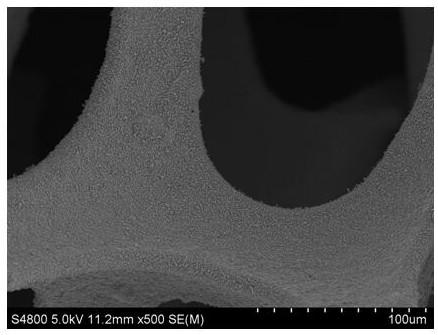A preparation method of a nitrogen-sulfur co-doped three-dimensional graphene foam electrode active material
A graphene foam, nitrogen-sulfur co-doping technology, applied in graphene, battery electrodes, circuits, etc., to achieve the effects of simple operation, low cost, and broad application prospects
- Summary
- Abstract
- Description
- Claims
- Application Information
AI Technical Summary
Problems solved by technology
Method used
Image
Examples
Embodiment 1
[0021] (1) First, disperse 50mg of graphene oxide in a mixed solvent of 70ml of deionized water and 10ml of ethanol to obtain a graphene oxide dispersion. After ultrasonic stripping of graphene oxide, add 0.03g of melamine and 0.04g of thiocyanate in sequence , Stir at 80°C until completely dissolved.
[0022] (2) Immerse 30*60*0.5mm nickel foam into the liquid of (1), and then put it into a 100ml polytetrafluoroethylene reactor for hydrothermal reaction. The hydrothermal reaction time is 4 hours, and the hydrothermal temperature is 100°C.
[0023] (3) After freeze-drying, the hydrothermal product was placed in a tube furnace, and the temperature was raised to 500°C at a rate of 2°C / min for 5 hours under an atmosphere protected by argon.
[0024] (4) Immerse the product in 5% dilute hydrochloric acid, stir magnetically at 80°C for 12 hours, and etch off the nickel foam. Then centrifuged and washed 6 times, dried to obtain the sample.
Embodiment 2
[0026] (1) First, disperse 100mg of graphene oxide in a mixed solvent of 25ml of deionized water and 25ml of ethanol to obtain a graphene oxide dispersion, then add 0.03g of melamine and 0.04g of thiocyanate in turn, and stir at 80°C until completely dissolve.
[0027] (2) Immerse 30*60*1mm nickel foam into the liquid of (1), and then put it into a 100ml polytetrafluoroethylene reactor for hydrothermal reaction. The hydrothermal reaction time is 24 hours, and the hydrothermal temperature is 150°C.
[0028] (3) After freeze-drying, the hydrothermal product was placed in a tube furnace, and the temperature was raised to 600°C at a rate of 5°C / min for 2 hours under an argon-protected atmosphere.
[0029] (4) Immerse the product in 5% dilute hydrochloric acid, stir magnetically at 80°C for 12 hours, and etch off the nickel foam. Then centrifuged and washed 6 times, dried to obtain the sample.
Embodiment 3
[0031] (1) First, disperse 100mg of graphene oxide in a mixed solvent of 50ml of deionized water and 10ml of ethanol to obtain a graphene oxide dispersion, then add 0.12g of melamine and 0.17g of thiocyanate in sequence, and stir at 80°C until completely dissolve.
[0032] (2) Immerse 30*60*2mm nickel foam into the liquid of (1), and then put it into a 100ml polytetrafluoroethylene reactor for hydrothermal reaction. The hydrothermal reaction time is 36 hours, and the hydrothermal temperature is 200°C.
[0033] (3) After freeze-drying, the hydrothermal product was placed in a tube furnace, and the temperature was raised to 800°C at a rate of 10°C / min under an argon-protected atmosphere for 1 hour.
[0034] (4) Immerse the product in 5% dilute hydrochloric acid, stir magnetically at 80°C for 12 hours, and etch off the nickel foam. Then centrifuged and washed 6 times, dried to obtain the sample.
[0035] Refer to attached Figure 1~3 , figure 1 Low magnification scanning ele...
PUM
| Property | Measurement | Unit |
|---|---|---|
| thickness | aaaaa | aaaaa |
Abstract
Description
Claims
Application Information
 Login to View More
Login to View More - R&D
- Intellectual Property
- Life Sciences
- Materials
- Tech Scout
- Unparalleled Data Quality
- Higher Quality Content
- 60% Fewer Hallucinations
Browse by: Latest US Patents, China's latest patents, Technical Efficacy Thesaurus, Application Domain, Technology Topic, Popular Technical Reports.
© 2025 PatSnap. All rights reserved.Legal|Privacy policy|Modern Slavery Act Transparency Statement|Sitemap|About US| Contact US: help@patsnap.com



